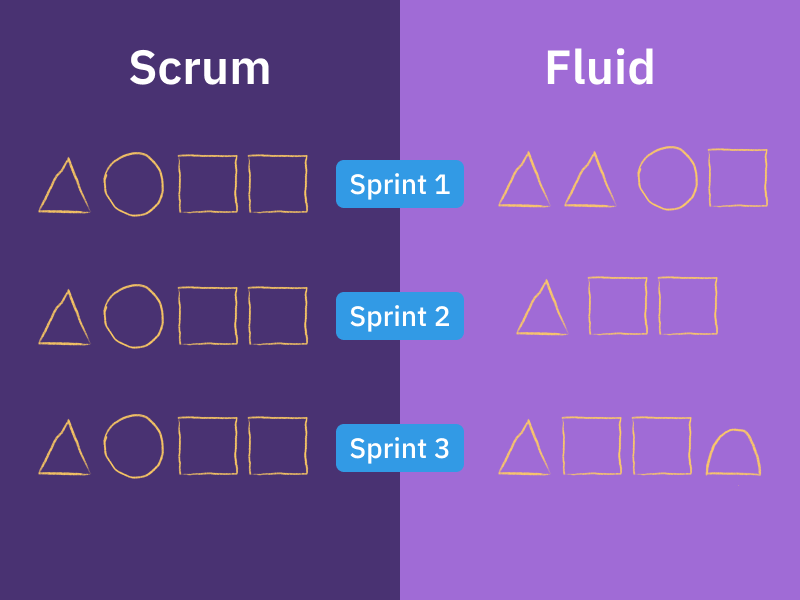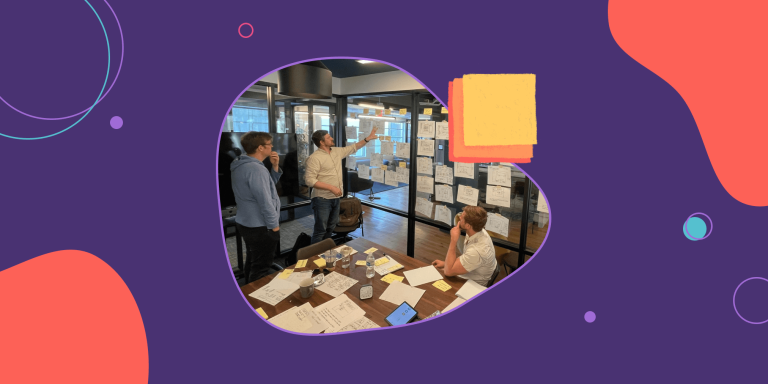Fluid Teams: The Next Evolution of Agile?

The concept of fluid teams is rapidly gaining traction. It takes the concept of a Scrum team and turns it on its head. The familiar Scrum processes and accountabilities remain, but team membership is allowed to flow and change as needed, sometimes even after every sprint.
Could fluid teams be the next popular iteration in Agile ways of working?
Proponents say that allowing teams to change organically is just another way to improve flexibility and resource management. While detractors insist it risks weakening established teams that have built strong bonds over multiple sprints.
We’re not here to tell you which side is right or wrong. Instead, we’ll take a look at both sides of the argument and include tips on how to experiment with fluid teams so you can determine whether this practice is the change your team needs.
What Are Fluid Teams?
Fluid teams are a concept where team composition is dynamic and can change as needed to meet the evolving requirements of a project. Unlike traditional fixed teams, where members remain constant throughout a project, fluid teams adapt by reallocating resources and personnel based on the current phase of work, skills required, and challenges faced. This approach is in line with Agile principles, which emphasize flexibility, responsiveness to change, and continuous improvement.
Why Would Someone Try Implementing Fluid Teams?
Traditionally, Scrum teams are fairly static. Team members might leave or join, but overall, the group of roughly eight to ten people remains unchanged from sprint to sprint.
In larger projects or organizations, you often have multiple Scrum teams working in parallel. The goal of fluid teams is to ensure you use the skills and talents of all the people across all your teams as effectively as possible. Instead of taking a 50-person team and splitting them into five or six rigid Scrum groups, you allow that 50-person roster to move in and out of temporary teams based on the current needs of a project and their expertise.

For instance, let’s say your current sprint goal is to develop a new feature for your app. At the beginning of the sprint, the Product Owner will describe what they need, and then each team member can decide whether their skills and expertise are best suited to accomplishing this task.
In this way, teams are allowed to organically form with the right mix of skills for the task at hand, enhancing efficiency and adaptability without disrupting cohesion or overarching project timelines.
What Do Sprints Look Like With Fluid Teams?
Now that you have a basic idea of fluid teams, it’s time to talk about how it really works in practice.
Let’s say that your development team consists of 30 people arranged into three Scrum teams. Typically, sprints last one week, with Scrum Masters and Product Owners setting sprint goals on Monday and doing Sprint Reviews and Retrospectives on Friday.
With fluid teams, this would still work much the same way, with the biggest difference being how the teams are formed:
- At the start of the sprint, all 30 team members would learn about the week’s sprint goals from the Product Owner. Next, the team would organize itself around these goals, making as many fluid teams as needed to get the jobs done. Each team member is free to decide where their talents would be best put to use in this sprint but will generally stay with that team until the sprint is done.
- Every day after this, each temporary team will hold its own Standup Meetings, just as they would in a stable Scrum team.
- At the end of the sprint, there will be one large Sprint Review with the entire team of 30, where everyone can find out how the week’s work went.
As with many Agile frameworks or concepts, there is no one right way to implement fluid teams, and each organization can choose to adjust this concept to meet their needs.
For instance, some organizations may not be comfortable having everyone reorganize after every sprint. Instead, they could opt to keep half the group stable while allowing the other half to flow between the teams more fluidly.
This makes the concept of fluid teams incredibly… fluid. Generally, it’s practiced with Scrum teams, but there’s no reason other organizations couldn’t try to implement these same practices in their work. In fact, many already do, with fluid teams already incredibly common in fields like healthcare.
The Benefits of Fluid Teams
So, what’s the case for adopting fluid teams? Here are four potential benefits that might persuade you to give fluid teams a try.
- Optimized resource utilization: Team members have the opportunity to use their skills where they can have the largest impact on team success.
- Cross-functional skill development: Team members get a chance to work on a variety of projects, which helps them acquire a broader range of skills.
- Better problem-solving: Diverse perspectives from an ever-changing team can foster innovative solutions and creative problem-solving that might be stifled in more static team structures.
- Improved employee satisfaction: Employees have opportunities to work on different projects, face new challenges, and avoid the monotony of being stuck in a single role for too long, which can increase job satisfaction.
The Potential Drawbacks of Fluid Teams
Fluid teams come with drawbacks too. Here are some of the main ones you should consider:
- Challenges in team cohesion: Teams with frequently changing members don’t get the time they need to bond, establish trust, and create a strong culture that can lead to better work outcomes.
- Increased management overhead: Product Owners and Scrum Masters may find it more difficult to monitor and improve on team dynamics when teams so often change.
- Potential for burnout and overload: There is a risk that highly skilled or in-demand team members might burn out as they’re moved from one high-priority task to another.
- Difficulty in performance assessment: With team members shifting so often, it can be difficult to track contributions and evaluate performance effectively.
Ultimately, no Agile strategy comes without its flaws. If these downsides seem acceptable or manageable to you, it’s time to look at how to successfully experiment with fluid teams.
Tips For Experimenting With Fluid Teams
At this point, some people may feel that trying something as new and untested as fluid teams is not worth the risk. However, it’s important to remember that sometimes you may not have a choice.
Crisis situations or holiday seasons, when many people are out on PTO, may force typically rigid teams to experiment with a more fluid approach. In these cases, these five tips can help you get the most out of your experiments or temporary situations.
- Start small: Organizations do not need to convert everyone to fluid teams all at once. Start by having two or three teams convert from stable to fluid teams and then expand as necessary.
- Clear communication: Invest time and effort into making your larger team meetings as effective as possible so that team members can stay connected to the progress made across all of the fluid teams.
- Look out for burnout: Run health checks and pay close attention to people who are always in demand by teams. Not only do you need to ensure they don’t get overworked, but it may also point to a crucial skill that you need more of on your team.
- Foster a strong team culture: Even in a fluid environment, it’s important to cultivate a sense of team unity and culture. Regular team-building activities and open communication help build trust and a sense of belonging, which are crucial for collaboration.
- Monitor and adapt the process: Continuously monitor the effectiveness of the fluid team approach and be open to adapting the strategy. Gather feedback from team members and stakeholders to understand what’s working and what isn’t and make adjustments accordingly.
If you follow these basic tips, you’ll give your teams the best possible chance of success in a fluid environment.
Don’t Be Afraid to Try Something New
Regardless of how comfortable or happy you are with your current workplace management style, there’s always room for improvement. The only way to do that is by experimenting with new ideas, concepts, and strategies.
If you’ve been using Scrum, Kanban, or some other methodology, it might be worth considering whether another Agile methodology would better serve your team. Take a look at our breakdown of the top Agile methodologies and frameworks of 2024 so you can determine if there’s some other framework that could get even more productivity out of your team.









